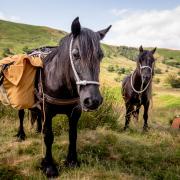This Chorley born woman’s extraordinary early life is matched only by her surrealist paintings, writes Barbara Waite

A celebrated Surrealist painter lauded world-wide but scarcely heard of in her native Lancashire is the subject of a major retrospective exhibition opening at Tate Liverpool in March.
Leonora Carrington built up a massive international reputation, especially in America and Mexico where she lived until her death in 2011. Today, she is acknowledged as one of the few female exponents of the genre.
The only girl in a family of boys, Leonora Carrington was born in Chorley the daughter of a millionaire textile magnate. At an early age the family moved to a rambling gothic mansion called Crookhey Hall at Cockerham. Although she only lived there until she was ten its ‘sinister towers, chimneys and gables’ haunted her memories and featured in some of her later paintings.
The family moved to Hazelwood Hall, a Victorian mansion at Silverdale but Leonora was a determined and restless spirit and after being expelled from school she studied art and, to her parents shock, rejected the aristocrat they picked out for her and eloped with a married, impoverished artist twice her age. He was the celebrated Surrealist Max Ernst.

They moved to Paris and mixed with Salvador Dalí, Marcel Duchamp, Man Ray, Joan Miró and Pablo Picasso before heading south where Ernst was arrested by the Nazis. In trying to get him set free she had a breakdown and fled to Madrid where she too was locked up – in a lunatic asylum.
In a bizarre incident, her parents sent a warship to bring her home but she escaped by travelling to Lisbon with a Mexican diplomat she had known through Picasso in Paris. They married in the British embassy and set sail first for America and then on to Mexico meeting the now-liberated Max Ernst and his new partner, the wealthy art patron Peggy Guggenheim, along the way.
It was after arriving in Mexico in 1942 that Leonora’s practice expanded further as she populated plays, sculptures and textiles with her extraordinary worlds. In 1947 her work was included in an international exhibition of surrealism in New York, where she was the only female British artist featured.
After this she designed set and costumes for productions including some of her own and performed as an actress. Her marriage of convenience over, she married a photographer, Hungarian immigrant Chiki Weisz, and had two sons. She was awarded an OBE in 2000 and was working right up to her death.

Date at the Tate
A prolific painter, the exhibition – featuring two other artists under the umbrella title Surreal Landscapes - looks at how the artist established her distinctive take on Surrealism; characterised by eccentric beings which shift between plant, animal, human and object; between reality and otherworldliness.
Taking key paintings as its starting point the exhibition examines Leonora’s diverse practice and uses the artist’s own words, brought together by London-based Mexican author Chloe Aridjis, to narrate the display.
A major highlight in the exhibition is The Magical World of the Mayas 1963, a 4.5 metre long mural she painted for the opening of the new Museo Nacional de Antropología in Mexico City in 1964. On display for the first time outside Mexico, it serves as a monument to her adopted country.
Refusing to be constrained or restricted by expectations or conventional limitations, Leonora’s expanded practice has made her an inspiration to many contemporary artists working across a range of mediums.
Leonora Carrington is at Tate Liverpool from March 6 to 31 May 31.



























